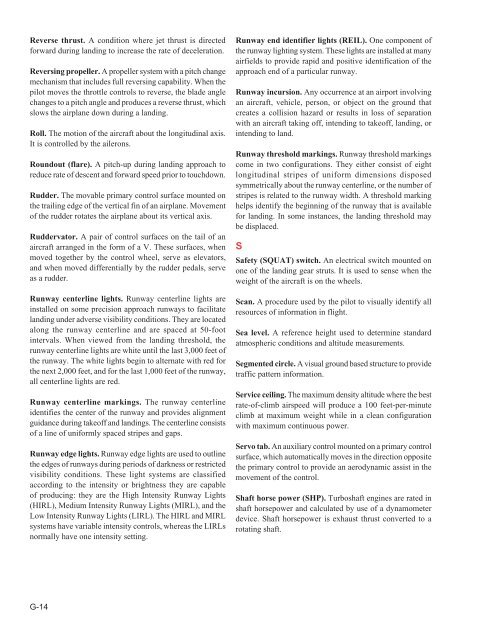Create successful ePaper yourself
Turn your PDF publications into a flip-book with our unique Google optimized e-Paper software.
Reverse thrust. A condition where jet thrust is directed<br />
forward during landing to increase the rate of deceleration.<br />
Reversing propeller. A propeller system with a pitch change<br />
mechanism that includes full reversing capability. When the<br />
pilot moves the throttle controls to reverse, the blade angle<br />
changes to a pitch angle and produces a reverse thrust, which<br />
slows the airplane down during a landing.<br />
Roll. The motion of the aircraft about the longitudinal axis.<br />
It is controlled by the ailerons.<br />
Roundout (flare). A pitch-up during landing approach to<br />
reduce rate of descent and forward speed prior to touchdown.<br />
Rudder. The movable primary control surface mounted on<br />
the trailing edge of the vertical fin of an airplane. Movement<br />
of the rudder rotates the airplane about its vertical axis.<br />
Ruddervator. A pair of control surfaces on the tail of an<br />
aircraft arranged in the form of a V. These surfaces, when<br />
moved together by the control wheel, serve as elevators,<br />
and when moved differentially by the rudder pedals, serve<br />
as a rudder.<br />
Runway centerline lights. Runway centerline lights are<br />
installed on some precision approach runways to facilitate<br />
landing under adverse visibility conditions. They are located<br />
along the runway centerline and are spaced at 50-foot<br />
intervals. When viewed from the landing threshold, the<br />
runway centerline lights are white until the last 3,000 feet of<br />
the runway. The white lights begin to alternate with red for<br />
the next 2,000 feet, and for the last 1,000 feet of the runway,<br />
all centerline lights are red.<br />
Runway centerline markings. The runway centerline<br />
identifies the center of the runway and provides alignment<br />
guidance during takeoff and landings. The centerline consists<br />
of a line of uniformly spaced stripes and gaps.<br />
Runway edge lights. Runway edge lights are used to outline<br />
the edges of runways during periods of darkness or restricted<br />
visibility conditions. These light systems are classified<br />
according to the intensity or brightness they are capable<br />
of producing: they are the High Intensity Runway Lights<br />
(HIRL), Medium Intensity Runway Lights (MIRL), and the<br />
Low Intensity Runway Lights (LIRL). The HIRL and MIRL<br />
systems have variable intensity controls, whereas the LIRLs<br />
normally have one intensity setting.<br />
Runway end identifier lights (REIL). One component of<br />
the runway lighting system. These lights are installed at many<br />
airfields to provide rapid and positive identification of the<br />
approach end of a particular runway.<br />
Runway incursion. Any occurrence at an airport involving<br />
an aircraft, vehicle, person, or object on the ground that<br />
creates a collision hazard or results in loss of separation<br />
with an aircraft taking off, intending to takeoff, landing, or<br />
intending to land.<br />
Runway threshold markings. Runway threshold markings<br />
come in two configurations. They either consist of eight<br />
longitudinal stripes of uniform dimensions disposed<br />
symmetrically about the runway centerline, or the number of<br />
stripes is related to the runway width. A threshold marking<br />
helps identify the beginning of the runway that is available<br />
for landing. In some instances, the landing threshold may<br />
be displaced.<br />
S<br />
Safety (SQUAT) switch. An electrical switch mounted on<br />
one of the landing gear struts. It is used to sense when the<br />
weight of the aircraft is on the wheels.<br />
Scan. A procedure used by the pilot to visually identify all<br />
resources of information in flight.<br />
Sea level. A reference height used to determine standard<br />
atmospheric conditions and altitude measurements.<br />
Segmented circle. A visual ground based structure to provide<br />
traffic pattern information.<br />
Service ceiling. The maximum density altitude where the best<br />
rate-of-climb airspeed will produce a 100 feet-per-minute<br />
climb at maximum weight while in a clean configuration<br />
with maximum continuous power.<br />
Servo tab. An auxiliary control mounted on a primary control<br />
surface, which automatically moves in the direction opposite<br />
the primary control to provide an aerodynamic assist in the<br />
movement of the control.<br />
Shaft horse power (SHP). Turboshaft engines are rated in<br />
shaft horsepower and calculated by use of a dynamometer<br />
device. Shaft horsepower is exhaust thrust converted to a<br />
rotating shaft.<br />
G-14


